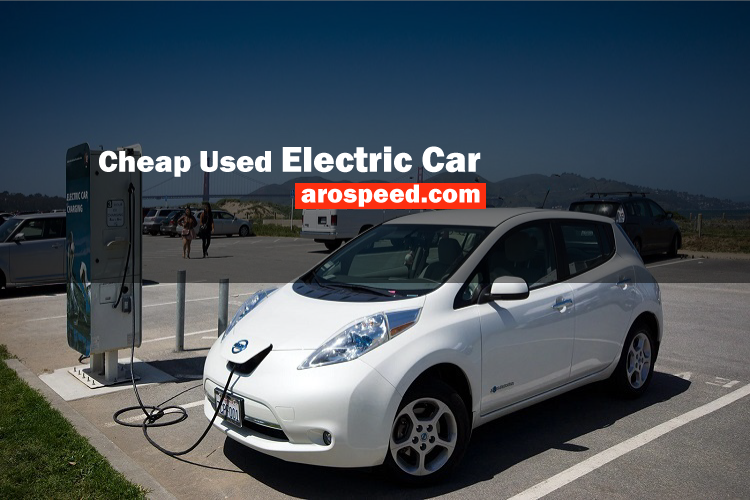To purchase cheap used electric cars we should know the capabilities of electric cars. Everyone wants to know and wait until the used cars price drop down. An electric traction motor powers an electric car, also known as an electric vehicle (EV), which is a passenger car that runs only on energy from its onboard batteries.
Electric cars offer greater energy conversion efficiency, are more responsive, quieter, produce no exhaust emissions, and have lower overall uses sports vehicle emissions when compared to traditional internal combustion engine (ICE) vehicles.
| Car model | Charging time | Price Range (in dollars) | Features |
| Nissan Leaf | 7.5 hrs | 10,000 – 15,000 | Regenerative braking, touchscreen, |
| Chevy spark EV | 7 hrs | 8000 – 12,000 | DC fast charging, compact size |
| BMW i3 | 4.5 hrs | 15,000 – 20,000 | Carbon fiber construction |
| Ford Focus EV | 5.5 hrs | 12,000 – 16,000 | MyFord Touch infotainment |
| Tesla Model S | 10 hrs | 25,000 – 35,000 | Autopilot, over-the-air updates |
| Fiat 500e | 4 hrs | 9,000 – 14,000 | Stylish design, city-friendly |
In general, the word “electric car” refers to battery electric vehicles (BEVs), although it can also apply to fuel cell electric vehicles (FCEV), plug-in hybrid electric vehicles (PHEVs), and range-extended electric vehicles (REEVs). To extend the cruising range of an electric car, the battery usually needs to be recharged by plugging it into a mains electricity power source.
Numerous charging stations are available for recharging electric vehicles; these stations can be built in parking garages, public spaces, and private residences. Research and development is also being done on other technologies, like inductive charging and battery swapping. Because the infrastructure for charging electric cars is still relatively new, range anxiety and time expense are common psychological barriers that prevent consumers from buying cheapest used electric automobiles. This is especially true for those with fast chargers.
10 million plug-in electric vehicles were sold globally in 2022, accounting for 14% of all new automobile sales, an increase from 9% in 2021. While numerous nations have passed laws to phase out the sale of automobiles that run on fossil fuels to minimize air pollution and slow down climate change, many other nations have developed government incentives for plug-in electric vehicles, including tax credits, subsidies, and other non-monetary incentives.
Almost one-fifth of all cars sold worldwide in 2023 are predicted to be electric vehicles (EVs), according to the International Energy Agency (IEA). With cumulative sales of 5.5 million units through December 2020, China currently possesses the largest inventory of electric vehicles worldwide. However, these figures only include vehicles made in China and do not include heavy-duty commercial vehicles like buses, garbage trucks, and sanitation vehicles.
Because they require less maintenance and fuel than comparable internal combustion engine cars, newer electric vehicles have a lower total cost of ownership in the US and the EU as of 2020. The Tesla Model Y surpassed all other cars in sales worldwide in 2023. Early in 2020, the Tesla Model 3 surpassed all other electric cars in the world in terms of sales, and in June 2021 it became the first electric vehicle to reach one million units worldwide.
The future of mobility is called Autonomous, linked, Electric, and Shared (ACES) Mobility, and it includes electric cars along with other emerging automotive technologies like shared mobility, autonomous driving, and linked vehicles.
Table of Contents
Terminology
The word “electric car” usually refers exclusively to battery electric vehicles (BEVs) or all-electric cars, which are a subset of electric vehicles (EVs) with an onboard rechargeable battery pack that can be charged from the grid and serves as the vehicle’s sole source of energy for wheel propulsion.
While most people associate the phrase with cars that can drive on highways, low-speed electric vehicles that meet certain weight, power, and speed restrictions can also be found on public roads.
In the US, these are referred to as Neighbourhood Electric Vehicles (NEVs); in Europe, they are called electric motorized quadricycles.
History
Somewhere between 1832 and 1839, Robert Anderson is frequently credited with creating the first electric automobile.
In the 1880s, the following electric vehicles in development were introduced:
- Gustave Trouvé debuted an electric vehicle at the Exposition Internationale d’Électricité de Paris in 1881, powered by an upgraded Siemens motor.
- Berlin hosted the world’s first trolleybus presentation by Werner von Siemens in 1882.
- Thomas Parker used his own specially designed high-capacity rechargeable batteries to build an electric car in Dudley in 1884, more than 20 years before the Ford Model T. The sole record of this project is a picture dated 1895.
- Some people believe that the Flocken Elektrowagen, created in 1888 by German Andreas Flocken, was the first “real” electric car.
- Andrew Morrison brought the first electric automobile to America in 1890.
In the late 19th and early 20th centuries, electricity was one of the most popular forms of automobile propulsion because it offered a degree of comfort and convenience of use that gasoline-powered vehicles could not match. At the turn of the 20th century, there were about 30,000 electric automobiles on the road.
Electric vehicles were first used for business purposes as taxis in the US and Britain in 1897. When taxis were drawn by horses, Walter Bersey’s electric cabs in London were the first self-propelled cars available for hire.
As an aspect of an endeavor, a fleet of eleven hansom taxis along with a brougham were constructed in New York City, partially based upon the Electrobat II design.
The major American producers of electric vehicles during the 20th century were Detroit Electric, Bailey Electric, Anderson, Edison, Riker, Milburn, Baker, and Columbia Electric. Their electric cars didn’t need to shift gears and were quieter than ones that ran on petrol.
Up to the development of internal combustion engines (ICE) and the mass manufacturing of less expensive petrol and diesel vehicles, such as the Ford Model T, electric cars were still very popular.[32] ICE used sports automobiles gained popularity due to their significantly faster refueling times and lower production costs.
The invention of the electric starter motor in 1912, however, which superseded earlier, frequently time-consuming techniques like manual cranking, was a pivotal event.
Modern electric cars
The California Air Resources Board (CARB) started promoting fuel-efficient, lower-emission cars in the early 1990s, with the ultimate objective of switching to zero-emission cars like electric vehicles. Automakers created electrified vehicles in response. The American automakers launched a huge campaign to undermine the concept of electric automobiles, which ultimately resulted in the withdrawal of these early models from the market.
The 2008 Tesla Roadster was initially delivered to consumers by California-based Tesla Motors, which started developing the vehicle in 2004. The Roadster was the first production all-electric vehicle to drive more than 320 km (200 miles) on a single charge and the first highway-legal all-electric vehicle to employ lithium-ion battery cells.
Better Place was a venture-backed business that originated in Israel and was headquartered in Palo Alto, California. It created and marketed battery replacement and charging services for electric vehicles. After going public on October 29, 2007, the company announced plans to install electric vehicle networks in Israel, Denmark, and Hawaii in 2008 and 2009.
The infrastructure would be implemented by the corporation nation-by-nation. Better Place and Renault-Nissan stated in January 2008 that they would collaborate to construct the first Electric Recharge Grid Operator (ERGO) model ever intended for Israel. As per the agreement, Renault-Nissan would supply the electric vehicles and Better Place would construct the grid for electric recharge.
In May 2013, Better Place declared bankruptcy in Israel. The company’s financial problems were brought on by poor management, excessively large investments needed to build the infrastructure for charging and swapping, a much lower market penetration than anticipated, and futile attempts to run pilots and establish toeholds in too many countries.
When the Mitsubishi i-MiEV was introduced in Japan in 2009, it became the first all-electric vehicle to sell more than 10,000 units and the first highway-legal series production electric car. A few months later, the 2010 Nissan Leaf—which was the best-selling all-electric vehicle at the time—became the best-selling vehicle.
The goal to lower greenhouse gas emissions and enhance the quality of the air in cities led to a rebirth in the production of electric vehicles beginning in 2008. This was facilitated by advancements in battery technology. With government backing, China’s electric vehicle market experienced significant growth in the 2010s.
However, before 2023, the subsidies that the Chinese government introduced will be reduced by 20 to 30 percent and eliminated. In anticipation of the modification to the subsidies, several automakers increased the price of their electric vehicles.
The Tesla Model S, which runs entirely on electricity, was named the “ultimate car of the year” in July 2019 by US-based Motor Trend magazine. With more than 500,000 delivered, the Tesla Model 3 surpassed the Nissan Leaf in March 2020 to take the top spot as the best-selling electric vehicle globally. In June 2021, it achieved the landmark of one million global sales.
According to a report by the Alliance for Automobile Innovation in the third quarter of 2021, the number of electric vehicles sold in the United States hit 6% of total light-duty automobile sales. This represents the largest volume of EV sales ever recorded, with 187,000 vehicles sold. Compared to a 1.3% gain in petrol and diesel-powered units, this represented an 11% increase in sales.
According to the survey, California led the US in EV sales with almost 40% of sales, followed by Florida with 6%, Texas with 5%, and New York with 4.4%.
Middle Eastern electric car manufacturers have been producing electric vehicles. The Mays i E1 was created by Mays Motors in Oman, and production is scheduled to start in 2023. With a range of roughly 560 km (350 miles), this carbon fiber vehicle can accelerate from 0 to 130 km/h (0 to 80 mph) in about 4 seconds. The EV manufacturer Togg is launching its electric vehicle production in Turkey. A cooperative venture with the Chinese company Farasis Energy will produce batteries.
Costs
Manufacturing cost
From €605 per kWh in 2010 to €170 in 2017 to €100 in 2019, the cost dropped. Converting current platforms may be less expensive for manufacturers producing low-production electric vehicles because development costs are lower; however, for higher production, a dedicated platform may be preferred to maximize design and cost.
Total cost of ownership
Because they require less maintenance and fuel than comparable petrol vehicles, modern electric automobiles have a lower total cost of ownership in the US, the EU, and China but not yet in China.
The likelihood that an electric car’s total cost of ownership will be lower than that of an equivalent internal combustion engine (ICE) vehicle increases with annual mileage. Depending on various energy costs, taxes, and subsidies, each country has a varied break-even distance. In certain nations, the comparison may fluctuate depending on the city, as different automobile types may incur varying entry fees in different places. For instance, in England, London charges ICE cars a higher fee than Birmingham.
Purchase cost
Several municipal and federal governments have implemented EV incentives to lower the cost of buying electric vehicles and other plug-in hybrids.
By 2020, the cost of an electric vehicle’s battery will account for over 25% of the vehicle’s overall cost. When battery costs drop below US$100 per kWh, which is predicted to happen in the mid-2020s, purchase prices are predicted to fall below those of new ICE cars.
In certain nations, leasing or subscriptions are common, based in part on national taxes and subsidies, and the market for used automobiles is growing as a result of end-of-lease vehicles.
According to an AlixPartners analysis from June 2022, the average EV cost of raw materials increased from $3,381 in March 2020 to $8,255 in May 2022. The primary causes of the cost increase are cobalt, nickel, and lithium.
List of cheap used electric cars
Chevrolet bolt
Of all the EVs available today, the Chevrolet Bolt has the longest range for the money. With a 259-mile range, the 2023 model costs only $26,500, which is over $10,000 less than it did a few years ago. Once the $7,500 federal tax credit is subtracted, the overall cost falls below $20,000.
State credits can also be reduced even further. The only thing to have in mind is that the battery technology is outdated. Although it hasn’t stated when the updated Bolt would be ready, General Motors plans to improve subsequent iterations of the Bolt using its new Ultium battery technology.
Chevy also provides free home installation for level two chargers. A level one charger is included with all EVs, however, it takes ten or more hours to charge an EV to the same extent as a level two charger does in half the time, therefore this is a significant upgrade for home charging.
Chevrolet bolt EUV
In terms of size and design, the Bolt EUV, or “electric utility vehicle,” is an improvement over the Bolt EV. It costs only a few thousand more than the Bolt at $27,800, but the cabin is larger. Chevrolet did not say whether or not the EUV is included in the savings of the Bolt, so if this affordable SUV is on your shortlist, you might want to move quickly.
Chevy’s Super Cruise autonomous driving technology, which lets you take your hands off the wheel while driving, is compatible with the Premier level ($32,000). According to MotorBiscuit, it’s a “multi-tasker’s dream.” But you have to stay focused and in control; you can’t take naps. A Bolt EUV with Super Cruise will set you back an extra $2,200, so the total cost of the vehicle includes at least $34,200 for these self-driving technologies.
Nissan Leaf EV
More than ten years ago, the Nissan Leaf was among the first electric cars available, and it has a decent performance history. It topped the Kelley Blue Book 5-Year Lowest Cost to Own list of cheap used electric cars last year. The Leaf’s 212-mile range is marginally less than that of both Bolts, which is a drawback. It’s on sale right now, but all indications point to it being taken off the market shortly.
For the 2024 model year, Nissan neglected to update the antiquated CHAdeMO charging port on the Leaf, despite the increasing use of other charging ports (CCS, NACS), particularly at public stations.
Chevrolet Equinox EV
The Chevy Equinox EV is a newcomer to the field of reasonably priced EVs, whereas the other of vehicles on this list have been in production for at least a few years. Although it is officially a 2024 model, the car will go on sale in autumn 2023. At 300 miles, it has the longest range on our list and is best and cheap vehicle for tall drivers.
A front-wheel-drive system with typical settings will provide 242 lb-ft of torque and 210 horsepower. It will provide 11.5 kW conventional Level 2 (AC), which is charged for 34 kilometers of range over one hour of battery life, and it will allow conventional DC rapid charging up to 150 kW to add about 70 miles more range in 10 minutes.
Mini cooper SE
The Mini Cooper EV has a lively and stylish look. Although its range is only 114 miles, it charges quite quickly—using a public fast charger, it takes only 36 minutes to reach 80% charge. This is an excellent two-door electric vehicle for commuting, reaching 60 mph in about seven seconds. It features stylish internal lighting, safety alarms, and an 8.5-inch touchscreen with an eye-catching circular pattern all around.
Hyundai Kona Electric
The Hyundai Kona Electric SUV has a good 258-mile range, which is one mile less than the Bolt EV. Its rear legroom is slightly less than that of the Bolt EUV (33.4 vs. 39.2 inches), but its trunk is larger.
There are presently three trim levels for the car. With only four color options, the entry-level SE ($33,550) features an 8-inch touchscreen, Android Auto, and Apple CarPlay. A couple of additional colors, a 10-inch screen, a sunroof, a digital key, and wireless device charging are included when you upgrade to the SEL level ($37,300).
A Harman Kardon sound system, heated steering wheel, smart cruise control, and leather seats are included with the high-end Limited grade ($41,550).
Volvo EX30
For this higher-end brand, the Volvo EX30 is a smart new electric vehicle (EV) with an astonishingly cheap starting price of $34,950. Additionally, it has a decent 275-mile range, which is comparable to the Tesla Model Y base model’s (279 miles) at a cost that is more than $10,000 cheaper.
Compared to the Model Y, the EX30’s body is smaller, making it ideal for maneuvering through urban streets. It also comes equipped with a warning indication to help you avoid “dooring” bicycles. It has the fastest 0-60 time of any Volvo to date, at 3.4 seconds. It also charges remarkably quickly, taking 26.5 minutes to go from 10% to 80%, which is about as quick as any EV we’ve seen.
Volkswagen ID.4
Regrettably, VW is no longer taking reservations for its well-liked ID.4 EV; nonetheless, the website advises interested parties to get in touch with their nearby dealers to inquire about availability.
Two variants of the 2023 Volkswagen ID.4 are available: the “Standard” model, which has a range of 208 miles, and the Pro version, which has a range of 275 miles and costs $43,995. Its heated seats and roomy 12-inch inside screen are features. Automatic braking and lane assistance are examples of self-driving features. According to Car and Driver, the inside cabin is roomy and quieter than in some other cars.
Three years of 30-minute rapid charging sessions at Electrify America stations are included as a bonus from Volkswagen. This allows the battery to be charged from 10% to 80% in around 35 minutes.
Conclusion
In conclusion, in today’s automotive scene, choosing a cheap used electric car is a practical and environmentally conscious decision. These cars considerably lessen carbon footprints in addition to providing a reasonably priced substitute for conventional gasoline-powered automobiles.
The growing market for cheap used electric cars offers consumers on a tight budget an affordable entry point to adopt sustainable mobility without breaking the bank. The pricing and efficiency of used electric cars are becoming better as technology develops and electric vehicles become more popular.
Accepting these environmentally responsible choices not only contributes to the worldwide trend toward greener solutions but also gives people the opportunity to enjoy the advantages of electric mobility without sacrificing their financial security. In the end, selecting a cheap used electric car is a wise decision for anyone looking for an economical and environmentally friendly driving solution because it complies with both financial responsibility and environmental standards.








Comments